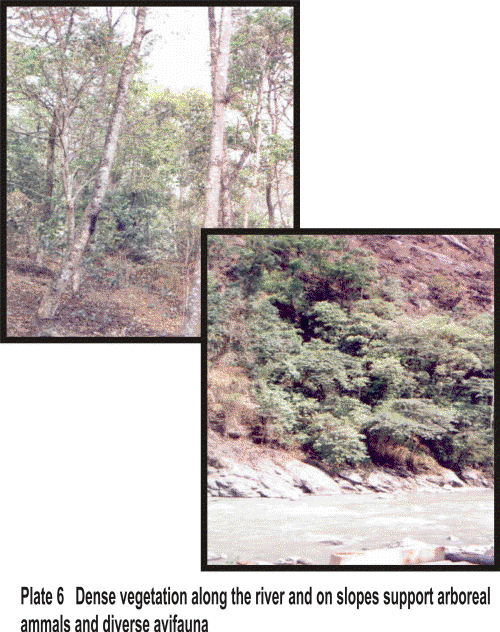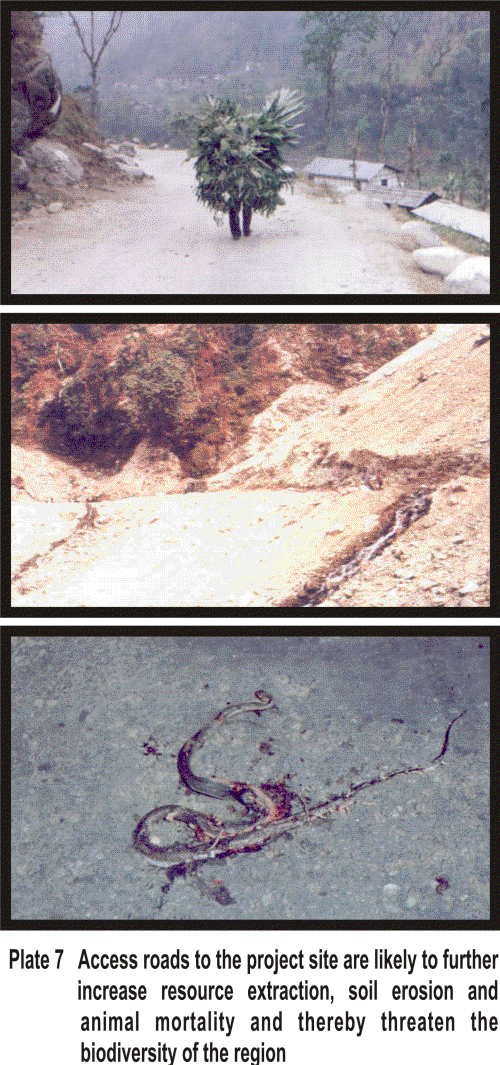Impact prediction
|
The most important step in the EIA process is the impact prediction that aid in decision making. Project induced changes can directly act upon environmental resource or conditions and can result in direct and indirect impacts (Fig 4). An attempt has been made here to identify primary and secondary impacts of proposed Project on the biological environment of the Project area. 5.1 IMPACTS ON VEGETATION AND WILDLIFE HABITATS The Project involves diversion of 123 ha. of forest land which will be largely used for construction of reservoir and dam structure. Land would also be diverted for laying access roads linking structures of intake tunnels, main adit to head race tunnel, adit to dam complex, ropeways, workshops and other facilities and disposal of waste. Nearly 67 ha. of the riparian stretch would be lost to submergence. Of which, 48.884 ha. of land would comprise of forest land. Plant species contributing to ground cover will be directly affected by massive earth work involved during the construction phase of the Project (construction of tunnels, complex, dam site, roads, culverts) and the construction of roads. The impacts are going to be far more significant on herbs, shrubs and climbers such as Aristolochia tagala, and Dioscorea spp., as these are likely to be removed by trampling and destruction of their root systems during construction operations. Species with limited regenerative capacity may be removed from the ground cover thus affecting the overall biodiversity of forest stands. It is inevitable that species such as Ficus auriculata, Ficus semicordata, Ficus benjamina and Ficus elastica that are the habitats for canopy dwelling arboreal mammals like flying squirrel and flying fox will be removed during clear felling operations. In the Project area, plant such as Aristolochia tagala, Litsea sp., Macaranga spp., Bombax ceiba, Albizzia spp., Dioscorea spp., Maesa sp., Osbeckia sp., Sida rhombifolia, Synedrella sp. and Ficus spp. are the important food plants for the butterflies such as Grapheum sarpedon, Appias lyncida, Eurema blanda, Loxura atymnus, Zemeros flegyas, Abisara fylla, Melanitis leda, Lethe europa, Precis almana and Euploe core. Project related activities involving clear felling of forests for construction of engineering structures, roads and disturbance induced by influx of Project staff and labourers will directly threaten the survival of these critically important fodder species of butterfly fauna of the region. Endangered plant species such as Livinstonea jenkinsiana and Calamus inermis which are endemic to some selected valleys of Sikkim Himalaya will become further restricted in distribution. Some rare plant species such as Ophiorrhiza lurida, Cissus spectabilis, Begonia rubella, Begonia satrapis and Phoenix rupicola are likely to become endangered in the Project area. Orchid flora of Sikkim is commercially valuable. Increased access to forested habitats that would be facilitated by roads may lead to increase in theft of orchid species leading to an overall decline of orchid species in the wild. 5.2 IMPACTS OF ROAD CONSTRUCTION AND EXPANSION Roads and forest degradation are generally inter linked. The project envisages broadening of some segments of existing road and construction of new roads. Based on the information provided by Project Authorities, the total length of roads to be built will be approximately 36 km. some of that is likely to traverse the forest stretches. Because of relatively slow growth, low productivity and often poor soil on steep and unstable slopes, these forest have little resilience to human disturbances. The fragmentation of natural vegetation resulting from road construction may lead to significant impacts on habitat quality and structure. The other important fact, which can not be overlooked, is that the construction of roads, do promote easy access to forests for pilferage of resources like timber, fuelwood, orchids and other economically and commercially important plant species (Plate 7). Construction of new roads and conversion of existing tracks into metalled surfaces are likely to increase erodability and instability of the natural forest tracts in the Project area. Roads can be source of rockfalls during road construction and maintenance. The disposed rubble that is transported to valleys leads to (i) destruction of vegetation in the valleys (ii) formation of impervious layers on soil limiting the regeneration of plant species and (iii) obstruction of water channels directly contributing to the reduced volume of water flow in the stream. High rainfall and steep terrain together would lead to increased slope instability and sedimentation of Teesta river. 5.3 IMPACTS ON MAMMALS Presence of seventeen species of mammals within the Project area was confirmed from direct and indirect sources. Project area, despite being affected by biotic influences such as human habitations, cultivation, grazing and forest resource exploitation supports species like flying squirrel (Petaurista Petaurista), Himalayan yellow throated marten (Martes flavigula) and hoary bellied squirrel (Callosciurus pygerythrus) (Plate 6). Felling of trees and increased human interference would adversely affect the survival of mammalian species. Further disturbances likely to be induced by Project related activities might force these species to disperse from the Project area. Non availability of suitable habitats for dispersing species outside the Project area may lead to these species becoming locally rare.
The only aquatic mammal found in Teesta river in the Project area is otter. Otters use rocky stretches along the river for denning and littering. Loss of such rocky banks subsequent to their inclusion in the submergence zone will adversely affect the otter populations due to destruction of denning sites. In downstream areas, the decrease in water level might make the existing habitat sub optimal for the species. This might force them to move away either to stretches further upstream or downstream that could be unsuitable habitats for this species. 5.4 IMPACTS ON AVIFAUNA Record of forty-seven species of birds in the Project area within a short period of reconnaissance does reflect potential richness of woodland bird habitat and avian diversity. The disturbance associated with activities in the construction phase are a cause of concern for conservation of avian species particularly of those species that are dependent on specialized habitat within the Project area. Species like Indian pied hornbill (Anthracoceros malabaricus) which is already placed in schedule I of Indian Wildlife (Protection) Act (1972) will be most seriously impacted due to felling of plant species like Ficus elastica, Ficus semicordata, Ficus benjamina and Ficus auriculata. 5.5 IMPACTS ON AQUATIC FAUNA Reduction in water flow in the stretch between dam site and Power house may lead to changes in riverine ecology. Changes in riverine ecology may result in impacts on aquatic habitat and associated fish fauna. The reduction in water discharge is likely to affect benthic flora and fauna on which most of the fishes are dependent as it provides important food resources. Although thirty-seven species are reported from Teesta river system, only six species of fishes were recorded from the Project area during the survey. Of the six species recorded, Alwan snow trout (Schizithorax richardsonii) is a valuable game fish. It is primarily a bottom feeder and uses areas near large boulders submerged in water. Reduction in water flow in 18 km stretch between dam site and Power house might result in loss of habitat for this fish. Apart from this in general the phenomenon like fish migration might get completely disrupted. 5.6 IMPACTS ON BUTTERFLIES Occurrence of 183 species of butterflies in the Project area explains the high butterfly diversity. Out of the 183 species recorded during the study, 13 are rare and 11 species are placed under schedule I of the Wildlife (Protection) Act 1972. Rare and endangered species like Common albatross (Appias albina), Common wanderer (Pareronia valeria), Narrow spark (Sinthusa nasaka), Red caliph (Enispe euthymius), Common evening brown (Melanitis leda), Brighteye bushbrown (Mycalesis nicotia), Yellow kaiser (Penthema lisrada), Blue duchess (Euthalia duda), Cruiser (Vindula erota), Bamboo tree brown (Lethe europa), eastern courtier (Sephisa chandra), Autumn leaf (Doleschallia bisaltide) and Common lascar (Pantoporia hordonia) and Long branded blue crow (Euploea algea) were recorded from single sites and only once during the survey. Clearing of areas for colony and campsites may lead to complete removal of large number of larval food plants. Habitat destruction might also lead to destruction of butterfly egg, which in turn might lead to local extinction of species. Use of explosives during construction would generate large quantities of settable dust that would be deposited on plants. Deposition of dust on food plants and larval food plants would render such plants unpalatable and unsuitable for egg laying. This is viewed as serious impact of project on butterflies of Sikkim (Plate 8). |
Last Updated: October 5, 2015











